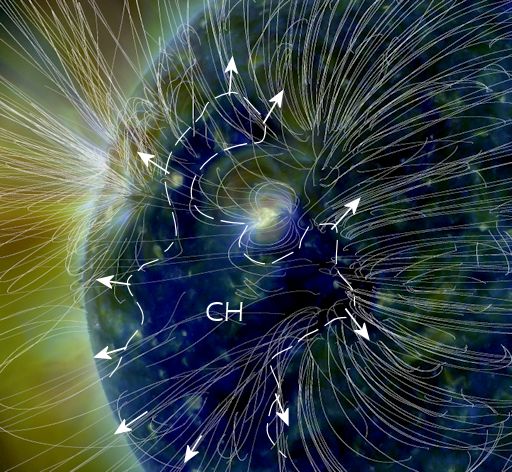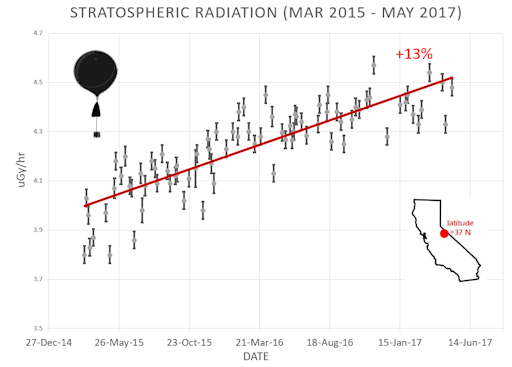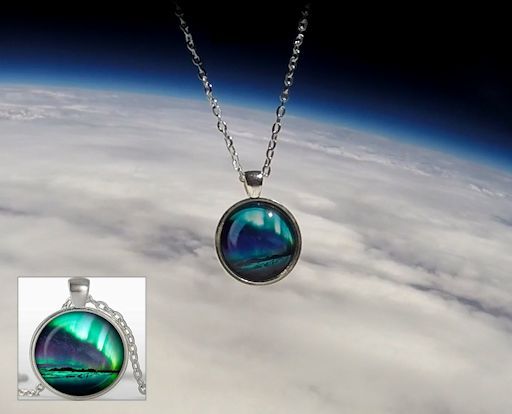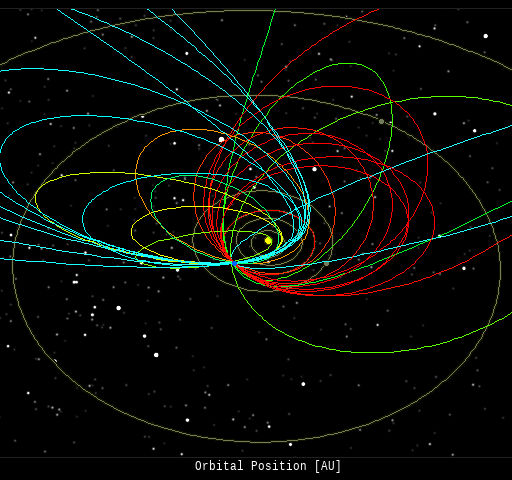Lights Over lapland is excited to announce that Autumn Aurora Adventures are available for immediate booking! Reserve your adventure of a lifetime in Abisko National Park, Sweden today! |
|
|
GEOMAGNETIC STORM WATCH: NOAA forecasters say G2-class geomagnetic storms are possible on May 17th when a CME is expected to deliver a glancing blow to Earth's magnetic field. High-latitude sky watchers should be alert for auroras, especially in the southern hemisphere where deepening autumn darkness favors visibility. Free: Aurora Alerts
POTENT CORONAL HOLE: Another coronal hole (CH) is turning toward Earth, and it is a potent one. NASA's Solar Dynamics Observatory photographed the structure on May 16th:

Image credit: NASA Solar Dynamics Observatory/LMSAL/Spaceweather.com
Coronal holes are places where the sun's magnetic field peels back and allows the solar wind to escape. Gaseous material flowing from this hole is moving very fast, more than 700 km/s. Moreover, the wind is threaded with "negative polarity" magnetic fields--and that's what makes it potent. Such fields do a good job connecting to Earth's magnetosphere and energizing geomagnetic storms.
This is a
The solar wind stream should reach Earth later this week, adding its effect to that of the CME due on May 17th. Stay tuned. Free: Aurora Alerts
Realtime
Aurora Photo Gallery
COSMIC RAYS ARE INTENSIFYING: As the sunspot cycle declines, we expect cosmic rays to increase. Is this actually happening? The answer is "yes." Spaceweather.com and the students of Earth to Sky Calculus have been monitoring radiation levels in the stratosphere with frequent high-altitude balloon flights over California. Here are the latest results, current as of May 6, 2017:

The data show cosmic ray levels intensifying with an approximately 13% increase since March 2015.
Cosmic rays are high-energy photons and subatomic particles accelerated in our direction by distant supernovas and other violent events in the Milky Way. Usually, cosmic rays are held at bay by the sun's magnetic field, which envelops and protects all the planets in the Solar System. But the sun's magnetic shield is weakening in 2017 as the solar cycle shifts from Solar Maximum to Solar Minimum. More and more cosmic rays are therefore reaching our planet.
How does this affect us? Cosmic rays penetrate commercial airlines, dosing passengers and flight crews enough that pilots are classified as occupational radiation workers. Some research shows that cosmic rays can seed clouds and trigger lightning, potentially altering weather and climate. Furthermore, there are studies ( #1, #2, #3, #4) linking cosmic rays with cardiac arrhythmias in the general population.
The sensors we send to the stratosphere measure X-rays and gamma-rays, which are produced by the crash of primary cosmic rays into Earth's atmosphere. The energy range of the sensors, 10 keV to 20 MeV, is similar to that of medical X-ray machines and airport security scanners.
NOTE: This increase is not happening ONLY over California. All parts of the world will be experiencing elevated levels of cosmic rays. The amount varies from place to place depending on the uneven protection afforded by our own planet's magnetic field. In the days ahead we will share new data from intercontinental balloon launches tracing the global response to this phenomenon.
Realtime
Space Weather Photo Gallery
THIS PENDANT HAS TOUCHED SPACE: The radiation monitoring program of Earth to Sky Calculus receives no support from corporate sponsors or government grants. Instead, we are crowd-funded. Or, to be more precise, bling- funded:

To raise money for more cosmic ray balloon flights, on May 6th the students launched a payload of these Northern Lights pendants to the top of Earth's atmosphere. You can have one for $79.95. Each piece of space jewelry comes with a greeting card showing the item in flight and telling the story of its journey to the stratosphere and back. They make great birthday and Mother's Day gifts.
More far-out gifts may be found in the Earth to Sky Store. All proceeds support atmospheric radiation monitoring and hands-on STEM education.
Realtime
Comet Photo Gallery
Every night, a network
of
NASA
all-sky cameras scans the skies above the United
States for meteoritic fireballs. Automated software
maintained by NASA's Meteoroid Environment Office
calculates their orbits, velocity, penetration depth
in Earth's atmosphere and many other characteristics.
Daily results are presented here on Spaceweather.com.
On May 02, 2024, the network reported 13 fireballs.
(7 eta Aquarid, 6 sporadics)

In this diagram of the inner solar system, all of the fireball orbits intersect at a single point--Earth. The orbits are color-coded by velocity, from slow (red) to fast (blue).
[Larger image] [movies]
Potentially Hazardous Asteroids (
PHAs)
are space rocks larger than approximately 100m that
can come closer to Earth than 0.05 AU. None of the
known PHAs is on a collision course with our planet,
although astronomers are finding
new
ones all the time.
On
May 3, 2024 there were 1801
potentially hazardous asteroids.
 |
Recent
& Upcoming Earth-asteroid encounters:
| Asteroid |
Date(UT) |
Miss Distance |
Velocity (km/s) |
Diameter (m) |
| 2024 GR1 |
2024-Apr-27 |
19.6 LD |
7.2 |
52 |
| 2024 HU1 |
2024-Apr-27 |
2.1 LD |
11 |
21 |
| 2024 HF2 |
2024-Apr-27 |
7.8 LD |
9 |
18 |
| 2024 HF1 |
2024-Apr-28 |
5 LD |
10.9 |
25 |
| 2024 GS4 |
2024-Apr-28 |
10.6 LD |
12.8 |
33 |
| 2024 GK5 |
2024-Apr-29 |
12.9 LD |
5.2 |
39 |
| 2024 HO2 |
2024-Apr-29 |
0.1 LD |
9.2 |
5 |
| 2021 GD3 |
2024-Apr-30 |
11.2 LD |
3.5 |
14 |
| 2024 HQ1 |
2024-Apr-30 |
2.2 LD |
5.5 |
8 |
| 2024 HZ2 |
2024-Apr-30 |
14.8 LD |
13.1 |
35 |
| 2024 HX2 |
2024-Apr-30 |
11.1 LD |
11.8 |
21 |
| 2022 TN1 |
2024-Apr-30 |
18.6 LD |
17.7 |
314 |
| 2024 HK2 |
2024-May-01 |
7.6 LD |
18.3 |
26 |
| 2022 AA5 |
2024-May-03 |
13.5 LD |
9 |
67 |
| 2024 HK1 |
2024-May-04 |
1.8 LD |
8.6 |
30 |
| 2024 HV1 |
2024-May-05 |
3.4 LD |
8.8 |
21 |
| 2024 HW1 |
2024-May-05 |
5 LD |
11 |
19 |
| 2024 FR5 |
2024-May-05 |
4.9 LD |
5.2 |
49 |
| 2024 HL2 |
2024-May-06 |
7.6 LD |
13.4 |
25 |
| 2024 HM2 |
2024-May-06 |
17.4 LD |
25 |
55 |
| 2024 HE2 |
2024-May-06 |
3.2 LD |
12.1 |
25 |
| 2021 JG9 |
2024-May-10 |
16.9 LD |
16.1 |
32 |
| 2016 FT14 |
2024-May-10 |
19.9 LD |
5.9 |
39 |
| 2015 KJ19 |
2024-May-14 |
15.8 LD |
23.1 |
112 |
| 2014 WF6 |
2024-May-14 |
7.2 LD |
18.9 |
47 |
| 2021 JN10 |
2024-May-14 |
17.5 LD |
13.2 |
33 |
| 2021 JJ |
2024-May-15 |
16.8 LD |
5.7 |
28 |
| 2022 WN2 |
2024-May-17 |
13.7 LD |
5.5 |
6 |
| 2019 VB5 |
2024-May-21 |
7.8 LD |
6.3 |
2 |
| 2024 HP |
2024-May-23 |
15.5 LD |
7.7 |
207 |
| 2024 HP2 |
2024-May-24 |
5.8 LD |
2.3 |
20 |
| 2008 LD |
2024-May-28 |
7.7 LD |
4.5 |
6 |
| 2021 LV |
2024-May-29 |
12 LD |
15.5 |
9 |
| 1998 KY26 |
2024-Jun-01 |
12 LD |
5.3 |
25 |
| 2016 JC6 |
2024-Jun-01 |
19.9 LD |
7.1 |
188 |
| 2008 YN2 |
2024-Jun-05 |
10.5 LD |
7.7 |
20 |
| 2021 LW3 |
2024-Jun-06 |
9.7 LD |
9.8 |
86 |
| 2024 CR9 |
2024-Jun-11 |
19.2 LD |
7.4 |
447 |
| 2022 XC1 |
2024-Jun-12 |
16.5 LD |
6.5 |
21 |
| 2022 WW11 |
2024-Jun-17 |
19.7 LD |
14.4 |
15 |
| 2019 NJ |
2024-Jun-27 |
17.2 LD |
10.1 |
66 |
| 415029 |
2024-Jun-27 |
17.3 LD |
25.9 |
2304 |
| 2022 MM1 |
2024-Jun-28 |
7.8 LD |
10.9 |
39 |
| 2010 XN |
2024-Jun-28 |
14.1 LD |
11.3 |
52 |
| 2022 HD1 |
2024-Jun-29 |
17.3 LD |
7.2 |
63 |
| 2017 MB3 |
2024-Jun-30 |
5 LD |
6.5 |
30 |
Notes: LD means
"Lunar Distance." 1 LD = 384,401 km, the distance
between Earth and the Moon. 1 LD also equals 0.00256
AU. MAG is the visual magnitude of the asteroid on
the date of closest approach.
| |
Cosmic Rays in the Atmosphere |
Readers, thank you for your patience while we continue to develop this new section of Spaceweather.com. We've been working to streamline our data reduction, allowing us to post results from balloon flights much more rapidly, and we have developed a new data product, shown here:

This plot displays radiation measurements not only in the stratosphere, but also at aviation altitudes. Dose rates are expessed as multiples of sea level. For instance, we see that boarding a plane that flies at 25,000 feet exposes passengers to dose rates ~10x higher than sea level. At 40,000 feet, the multiplier is closer to 50x. These measurements are made by our usual cosmic ray payload as it passes through aviation altitudes en route to the stratosphere over California.
What is this all about? Approximately once a week, Spaceweather.com and the students of Earth to Sky Calculus fly space weather balloons to the stratosphere over California. These balloons are equipped with radiation sensors that detect cosmic rays, a surprisingly "down to Earth" form of space weather. Cosmic rays can seed clouds, trigger lightning, and penetrate commercial airplanes. Furthermore, there are studies ( #1, #2, #3, #4) linking cosmic rays with cardiac arrhythmias and sudden cardiac death in the general population. Our latest measurements show that cosmic rays are intensifying, with an increase of more than 13% since 2015:

Why are cosmic rays intensifying? The main reason is the sun. Solar storm clouds such as coronal mass ejections (CMEs) sweep aside cosmic rays when they pass by Earth. During Solar Maximum, CMEs are abundant and cosmic rays are held at bay. Now, however, the solar cycle is swinging toward Solar Minimum, allowing cosmic rays to return. Another reason could be the weakening of Earth's magnetic field, which helps protect us from deep-space radiation.
The radiation sensors onboard our helium balloons detect X-rays and gamma-rays in the energy range 10 keV to 20 MeV. These energies span the range of medical X-ray machines and airport security scanners.
The data points in the graph above correspond to the peak of the Reneger-Pfotzer maximum, which lies about 67,000 feet above central California. When cosmic rays crash into Earth's atmosphere, they produce a spray of secondary particles that is most intense at the entrance to the stratosphere. Physicists Eric Reneger and Georg Pfotzer discovered the maximum using balloons in the 1930s and it is what we are measuring today.
| |
The
official U.S. government space weather bureau |
| |
The
first place to look for information about sundogs,
pillars, rainbows and related phenomena. |
| |
Researchers
call it a "Hubble for the sun." SDO
is the most advanced solar observatory ever. |
| |
3D
views of the sun from NASA's Solar and Terrestrial
Relations Observatory |
| |
Realtime
and archival images of the Sun from SOHO. |
| |
from
the NOAA Space Environment Center |
| |
a proud supporter of science education and Spaceweather.com |
| |
fun to read, but should be taken with a grain of salt! Forecasts looking ahead more than a few days are often wrong. |
| |
from the NOAA Space Environment Center |
| |
the
underlying science of space weather |
 |
Beautyz for top beauty products reviews and their buying guides |
 |
Reviews here can help you to pick up best memory foam mattresses. |
| |
These links help Spaceweather.com stay online. Thank you to our supporters! |
|
|
| |
|
|
|